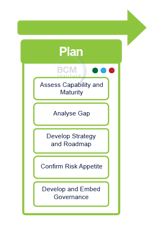
Develop Strategy Roadmap
|

|
What is Strategy Roadmap?
A strategy roadmap is a bridge between strategy and execution. It visualizes the critical outcomes of the operational resilience effort that must be delivered over a particular time horizon to achieve the organisation’s strategic vision.
The outcomes on the strategy roadmap are substantiated by a clear understanding of the organisation’s capabilities; gaps and priorities must be addressed.
|

 This section is the "Plan" phase of the Operational Resilience Planning Methodology. It is the second stage of the Plan phase: Develop Strategy Roadmap.
This section is the "Plan" phase of the Operational Resilience Planning Methodology. It is the second stage of the Plan phase: Develop Strategy Roadmap.
Audit Checklist for Develop Strategy Roadmap
1. Governance and Leadership
|
- Is there a clear governance structure in place for the operational resilience program?
- Are roles and responsibilities for program leadership clearly defined?
- Is there senior management oversight and involvement in the program?
- Are there mechanisms to escalate and resolve issues related to operational resilience?
|
- Establish a clear governance structure with defined roles and responsibilities for operational resilience.
- Ensure senior management oversight and involvement in the program.
- Develop policies and procedures to support effective governance and decision-making.
- Define mechanisms for escalation and resolution of operational resilience issues.
|
2. Risk Assessment and Identification
|
- Has a comprehensive risk assessment been conducted to identify potential operational risks?
- Are all critical business processes and dependencies identified?
- Have risk thresholds and impact tolerances been established?
- Is there a process to regularly update and reassess risks and dependencies?
|
- Develop a standardized risk assessment methodology for identifying and evaluating operational risks.
- Ensure all critical business processes, systems, and dependencies are identified.
- Establish risk thresholds and impact tolerances to prioritize risks. d. Implement a process for regular risk monitoring and reassessment.
|
3. Business Impact Analysis
|
- Has a business impact analysis been performed to assess the potential consequences of operational disruptions?
- Are critical functions and processes prioritized based on their impact on the organization?
- Are recovery time objectives (RTOs) and recovery point objectives (RPOs) defined for critical processes?
- Has the impact of interdependencies between processes been considered?
|
- Conduct a comprehensive business impact analysis to assess the potential consequences of operational disruptions.
- Prioritize critical functions and processes based on their impact on the organization.
- Define recovery time objectives (RTOs) and recovery point objectives (RPOs) for critical processes.
- Analyze interdependencies between processes to identify potential ripple effects.
|
- Has a strategy roadmap been developed to implement the operational resilience program?
- Are there explicit goals and objectives for the program?
- Is the strategy aligned with the organization's overall risk management and business continuity plans?
- Are resource requirements and budget considerations identified in the strategy?
|
- Define the vision, goals, and objectives of the operational resilience program.
- Align the strategy with the organization's overall risk management and business continuity plans.
- Identify resource requirements, including budget, personnel, and technology.
- Develop a roadmap with clear milestones and timelines for implementation.
|
5. Incident Response and Recovery
|
- Is there an incident response plan for different types of operational disruptions?
- b. Are roles and responsibilities clearly defined in the incident response plan?
- c. Has the plan been tested and updated regularly?
- Is there a process for learning from incidents and improving the operational resilience program?
|
- Establish an incident response plan that outlines procedures for responding to and recovering from operational disruptions.
- Define roles and responsibilities for incident management, including incident response teams.
- Regularly test and update the incident response plan to ensure its effectiveness.
- Establish mechanisms for learning from incidents and incorporating improvements into the operational resilience program.
|
6. Communication and Coordination
|
- Is there a communication plan to ensure effective communication during operational disruptions?
- Are stakeholders identified and informed about the operational resilience program?
- Is there coordination with external partners, vendors, and regulators during incidents?
- Are there mechanisms to provide timely updates to stakeholders and manage their expectations?
|
- Define the vision and objectives of the operational resilience program.
- Conduct a thorough assessment of the current state of operational resilience.
- Identify key stakeholders and establish communication channels.
- Develop a governance structure with clear roles and responsibilities.
- Define risk assessment methodologies and criteria.
- Perform a comprehensive risk assessment and document the findings.
- Conduct a business impact analysis to prioritize critical functions and processes.
- Develop recovery strategies and plans for critical processes.
- Identify resource requirements and budget considerations.
- Establish performance metrics and key performance indicators (KPIs) for measuring progress.
- Develop an incident response plan with clear escalation procedures.
- Test and validate the incident response plan through simulations and drills.
- Develop a communication plan for internal and external stakeholders.
- Establish mechanisms for ongoing monitoring and reporting of operational resilience.
- Regularly review and update the strategy roadmap to incorporate lessons learned and evolving risks.
|
Do note that some steps may overlap or appear similar in the other stages of the OR planning phases. If this occurs, the questionnaires and checklists must be contextualised to the topic under review.
Find out more about Blended Learning ORA-5000 [BL-ORA-5] & ORA-300 [BL-ORA-3]

 This section is the "Plan" phase of the Operational Resilience Planning Methodology. It is the second stage of the Plan phase: Develop Strategy Roadmap.
This section is the "Plan" phase of the Operational Resilience Planning Methodology. It is the second stage of the Plan phase: Develop Strategy Roadmap.

















![Email to Sales Team [BCM Institute]](https://no-cache.hubspot.com/cta/default/3893111/3c53daeb-2836-4843-b0e0-645baee2ab9e.png)

